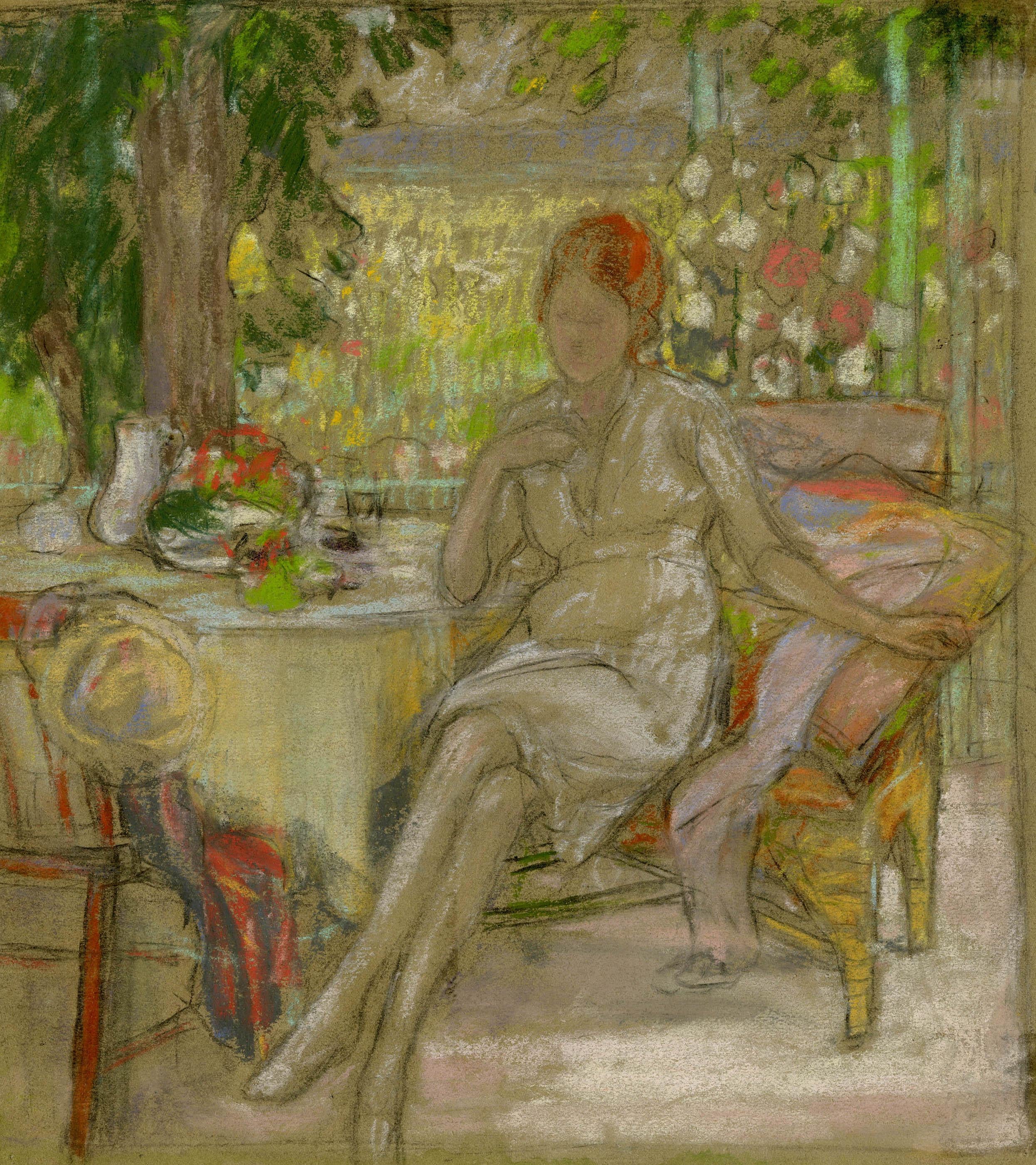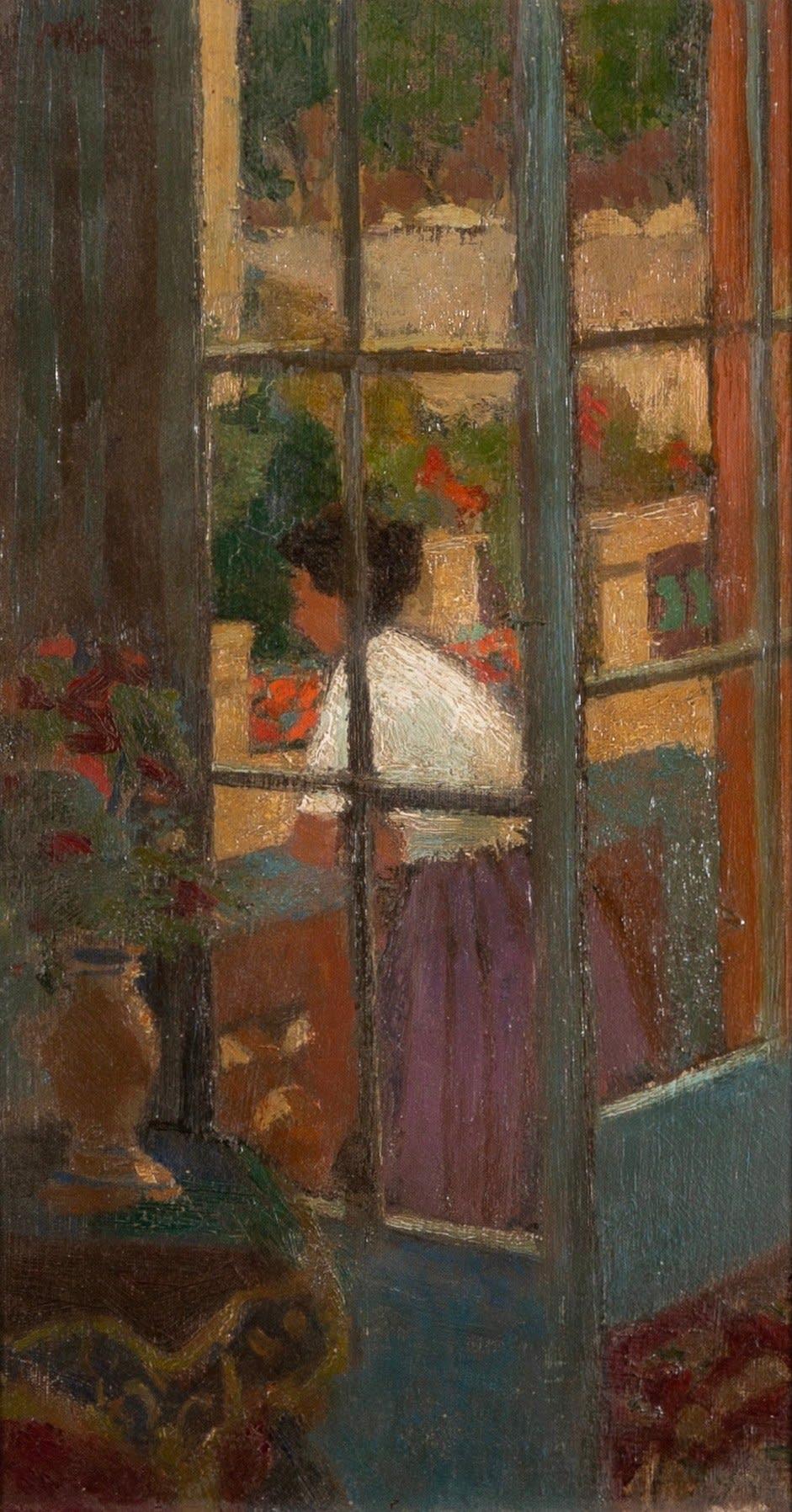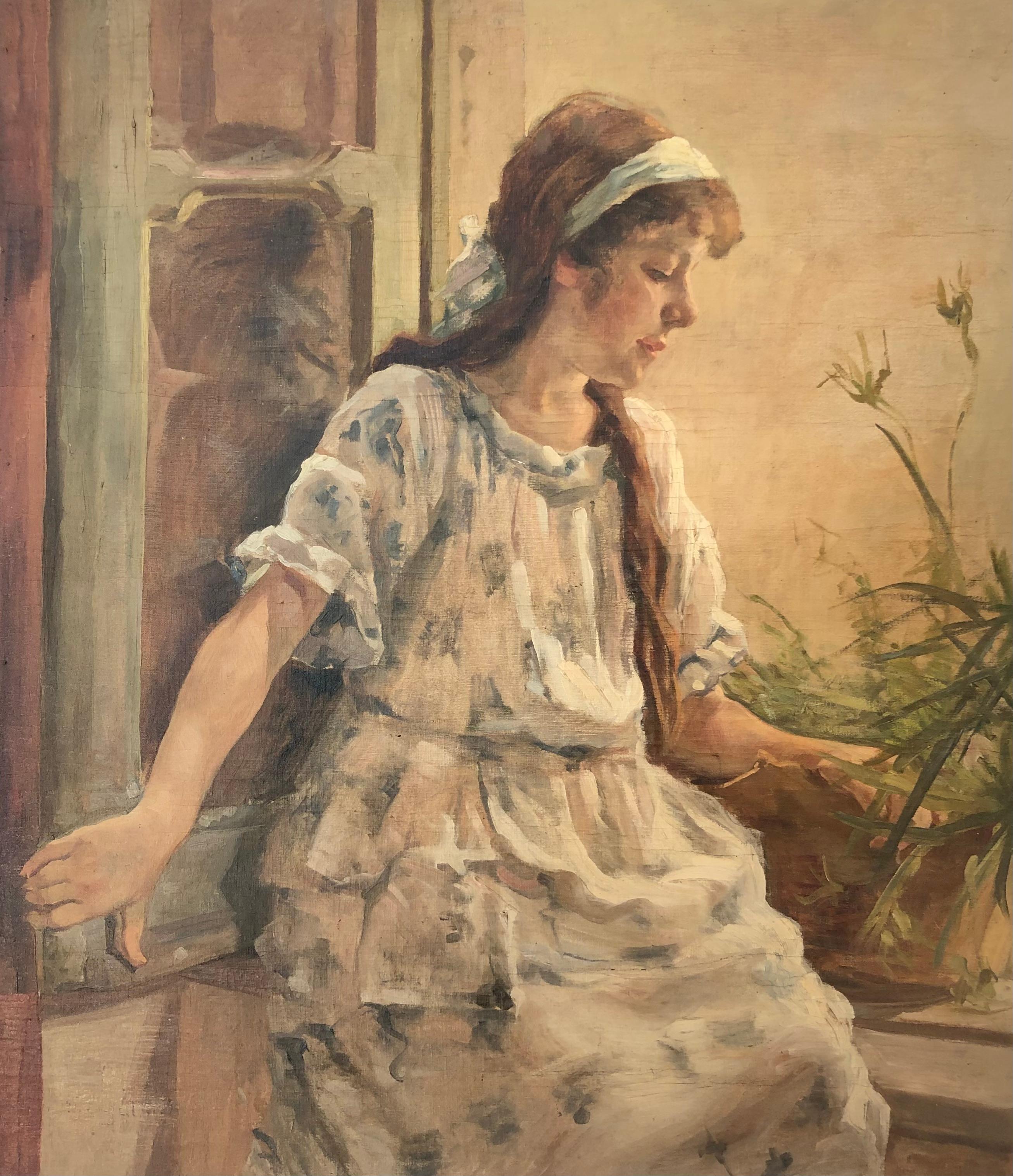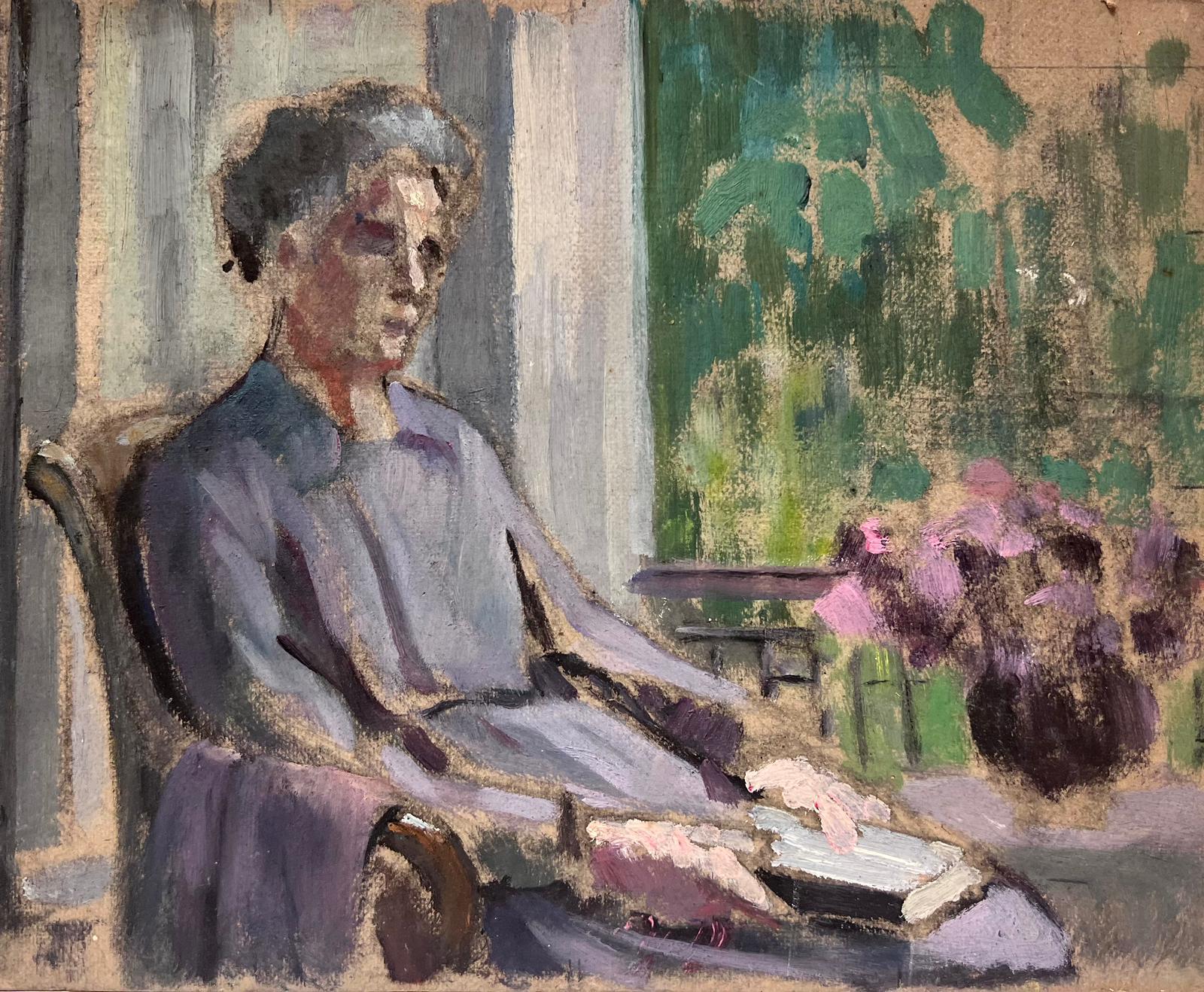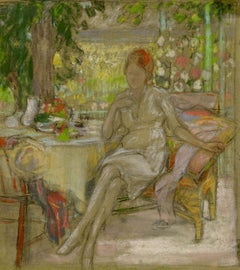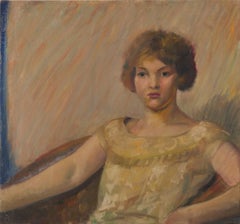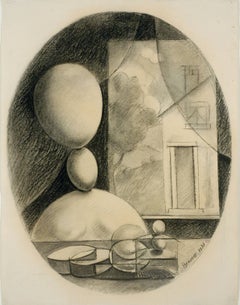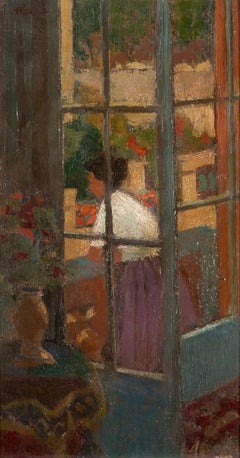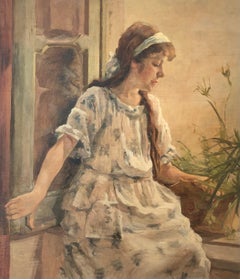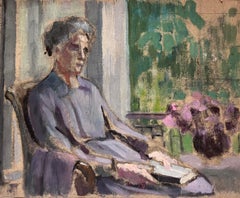Items Similar to untitled Woman by the Windows
Want more images or videos?
Request additional images or videos from the seller
1 of 6
Karl Albert Buehruntitled Woman by the Windowsc. 1915
c. 1915
$9,500
£7,163.94
€8,285.44
CA$13,328.45
A$14,815.40
CHF 7,765.91
MX$180,931.87
NOK 96,952.97
SEK 91,214.65
DKK 61,840.15
About the Item
Untitled (Woman by the Windows)
Unsigned.
Pastel on board, c. 1915
Created while the artist was in Giverny, France
Provenance:
Gift of the artist to his wife, Mary Hess Buehr
by Descent to the artist's niece, daughter of Will Hess.
David Salzman
Robert Henry Adams Fine Art, Chicago
Ronald C. Sloter, Columbus
One of the early Chicago artists to adopt Impressionism, Karl Buehr became a figure and landscape painter. As a figure painter, his specialty became "gorgeously colored images of young women on porches overlooking brilliant summertime gardens." (Kennedy 98) His later work often showed a female figure with serious expression engaging the viewer with a direct stare. In his landscapes, he was noted for his strong coloration. In a December 1896 student exhibition at the Art Institute, a reviewer for the "Chicago Times Herald" described Buehr's landscapes as "blithe and joyous" with "country roads brilliant in sunlight . . . fields rich in summer verdure, under soft skies painted in a high, musical key." (Gerdts 68)
Buehr was born as one of seven sons to a prosperous German family who immigrated to America and settled in Chicago in 1869. He was first exposed to his signature style of Impressionism in 1888 when he enrolled in night classes at the Art Institute while working in the shipping department of a lithographic firm near the Institute. He remained a student there until 1897 and was recognized in a "Chicago Times Herald" editorial of June 13, 1897 as one of the Institute's most outstanding pupils.
The next year, his art career was temporarily put on hold when he briefly enlisted with the U.S. Army in the Spanish American War. In 1899, he resumed his art studies, this time with Frank Duveneck. He exhibited a painting at the Paris Salon of 1900. In 1905, thanks to a wealthy Chicago patron, Buehr and his family moved to France. They spent the following year in Taormina, Sicily, and spent time in Venice as well. In Paris, Buehr studied at the Academy Julian with Raphael Collin for two years. Then he went to England, enrolling in the London Art School but had returned to Paris by 1908. During this time, he began painting at Giverny, the home of Impressionist leader Claude Monet (1840-1926, and by 1912, Buehr was listing that village as his home address. One of his good friends and associates at Giverny was Frederick Frieseke.
One of Buehr's paintings from that time, "News from Home", was exhibited in 1913 at the French Salon in Paris and at the annual exhibit of the Chicago Art Institute. It shows a woman in floral dress sitting on a porch with a background with potted flowers and lush greenery background. Of his painting done at Giverny, Buehr wrote in 1912 to William Macbeth of Macbeth Galleries in New York: "My figures painted in and around Giverny are costumed and in appropriate out door settings." (Gerdts 68)
In 1914, he returned to the United States and took a teaching position in Chicago at the Art Institute, which he held for the remainder of his life. He was married to Mary Hess, a painter of miniatures and decorative works.
In 1928-29, he was a guest artist at Stanford University.
Courtesy: AskArt
“Karl Albert Buehr (1866–1952) was a painter born in Germany.
Buehr was born in Feuerbach - near Stuttgart. He was the son of Frederick Buehr and Henrietta Doh (Dohna?). He moved to Chicago with his parents and siblings in the 1880s. In Chicago, young Karl worked at various jobs until he was employed by a lithograph company near the Art Institute of Chicago. Introduced to art at work, Karl paid regular visits to the Art Institute, where he found part-time employment, enabling him to enroll in night classes. Later, working at the Institute as a night watchman, he had a unique opportunity to study the masters and actually posted sketchings that blended in favorably with student's work. Having studied under John H. Vanderpoel, Buehr graduated with honors, while his work aroused such admiration that he was offered a teaching post there, which he maintained for many years thereafter. He graduated from the Art Inst. of Chicago and served in the IL Cav in the Spanish–American War. Mary Hess became Karl's wife—she was a student of his and an accomplished artist in her own right. In 1922, he was elected into the National Academy of Design as an Associate member.
Art Studies in Europe
In 1904, Buehr received a bronze medal at the St. Louis Universal Exposition, then, in 1905, Buehr and his family moved to France, thanks to a wealthy Chicago patron, and they spent the following year in Taormina, Sicily, where the artist painted local subjects, executing both genre subjects and landscapes as well as time in Venice. Buehr spent at least some time in Paris, where he worked with Raphaël Collin at the Académie Julian.
Giverny and American Impressionism
Prior to this time, Buehr had developed a quasi-impressionistic style, but after 1909, when he began spending summers near Monet in Giverny, his work became decidedly characteristic of that plein-air style but he began focusing on female subjects posed out-of-doors. He remained for some time in Giverny, and here he became well-acquainted with other well known expatriate America impressionists such as Richard Miller, Theodore Earl Butler, Frederick Frieseke, and Lawton Parker. It seems likely that Buehr met Monet, since his own daughter Kathleen and Monet’s granddaughter, Lili Butler, were playmates, according to George Buehr, the painter’s son. His other daughter Lydia died before adulthood due to diabetes. He returned to Chicago at the onset of World War I and taught at The Art Inst for many years. One of his noted pupils at the Art Institute was Archibald Motley, Jr. the famous African American "Harlem" Renaissance painters. Motley credits Buehr with being one of his finest teachers and one who encouraged his style.
Teaching Career in Chicago
Buehr remained an expressive colorist, but broadened his brushwork somewhat in later years when impressionism waned. Back in America, he was immediately successful. He won a silver medal at the Panama-Pacific International Exposition in San Francisco and the Purchase Prize of the Chicago Municipal Art Commission in the following year. So famed was Buehr that had a one-man exhibition at the Century of Progress Fair in Chicago in 1934.
After a long and exceedingly productive career, Karl Buehr died in Chicago at the age of eighty-six.”
Courtesy of Wikipedia
- Creator:Karl Albert Buehr (1866-1952, American)
- Creation Year:c. 1915
- Dimensions:Height: 10.625 in (26.99 cm)Width: 9 in (22.86 cm)
- Medium:
- Movement & Style:
- Period:
- Condition:Original.
- Gallery Location:Fairlawn, OH
- Reference Number:Seller: FA68341stDibs: LU14014708322
About the Seller
5.0
Recognized Seller
These prestigious sellers are industry leaders and represent the highest echelon for item quality and design.
Platinum Seller
Premium sellers with a 4.7+ rating and 24-hour response times
Established in 1978
1stDibs seller since 2013
808 sales on 1stDibs
Typical response time: <1 hour
Associations
International Fine Print Dealers Association
- ShippingRetrieving quote...Shipping from: Fairlawn , OH
- Return Policy
Authenticity Guarantee
In the unlikely event there’s an issue with an item’s authenticity, contact us within 1 year for a full refund. DetailsMoney-Back Guarantee
If your item is not as described, is damaged in transit, or does not arrive, contact us within 7 days for a full refund. Details24-Hour Cancellation
You have a 24-hour grace period in which to reconsider your purchase, with no questions asked.Vetted Professional Sellers
Our world-class sellers must adhere to strict standards for service and quality, maintaining the integrity of our listings.Price-Match Guarantee
If you find that a seller listed the same item for a lower price elsewhere, we’ll match it.Trusted Global Delivery
Our best-in-class carrier network provides specialized shipping options worldwide, including custom delivery.More From This Seller
View AllWoman on a Patio
By Karl Albert Buehr
Located in Fairlawn, OH
Woman on a Patio
Pastel on paper, c. 1915
Unsigned
Provenance: Gift of the artist to his wife, Mary Hess Buehr
By decent to the artist's niece, daughter of Will...
Category
1910s Abstract Impressionist Figurative Drawings and Watercolors
Materials
Pastel
Woman on a Patio
By Karl Albert Buehr
Located in Fairlawn, OH
Woman on a Patio
Pastel on paper, c. 1915
Unsigned
Provenance: Gift of the artist to his wife, Mary Hess Buehr
By decent to the artist's niece, daughter of Will Hess
David Saltzman
Robert Henry Adams Fine Art
Thomas French Fine Art
Ronald C. Sloter, Columbus, Ohio
Columbus College of Art and Design (de-accessed)
Exhibited at Robert Henry Adams Fine Art, 1994, the first exhibition at the North Franklin Street Gallery.
One of the early Chicago artists to adopt Impressionism, Karl Buehr became a figure and landscape painter. As a figure painter, his specialty became "gorgeously colored images of young women on porches overlooking brilliant summertime gardens." (Kennedy 98) His later work often showed a female figure with serious expression engaging the viewer with a direct stare. In his landscapes, he was noted for his strong coloration. In a December 1896 student exhibition at the Art Institute, a reviewer for the "Chicago Times Herald" described Buehr's landscapes as "blithe and joyous" with "country roads brilliant in sunlight . . . fields rich in summer verdure, under soft skies painted in a high, musical key." (Gerdts 68)
Buehr was born as one of seven sons to a prosperous German family who immigrated to America and settled in Chicago in 1869. He was first exposed to his signature style of Impressionism in 1888 when he enrolled in night classes at the Art Institute while working in the shipping department of a lithographic firm near the Institute. He remained a student there until 1897 and was recognized in a "Chicago Times Herald" editorial of June 13, 1897 as one of the Institute's most outstanding pupils.
The next year, his art career was temporarily put on hold when he briefly enlisted with the U.S. Army in the Spanish American War. In 1899, he resumed his art studies, this time with Frank Duveneck. He exhibited a painting at the Paris Salon of 1900. In 1905, thanks to a wealthy Chicago patron, Buehr and his family moved to France. They spent the following year in Taormina, Sicily, and spent time in Venice as well. In Paris, Buehr studied at the Academy Julian with Raphael Collin for two years. Then he went to England, enrolling in the London Art School but had returned to Paris by 1908. During this time, he began painting at Giverny, the home of Impressionist leader Claude Monet (1840-1926, and by 1912, Buehr was listing that village as his home address. One of his good friends and associates at Giverny was Frederick Frieseke.
One of Buehr's paintings from that time, "News from Home", was exhibited in 1913 at the French Salon in Paris and at the annual exhibit of the Chicago Art Institute. It shows a woman in floral dress sitting on a porch with a background with potted flowers and lush greenery background. Of his painting done at Giverny, Buehr wrote in 1912 to William Macbeth of Macbeth Galleries in New York: "My figures painted in and around Giverny are costumed and in appropriate out door settings." (Gerdts 68)
In 1914, he returned to the United States and took a teaching position in Chicago at the Art Institute, which he held for the remainder of his life. He was married to Mary Hess, a painter of miniatures and decorative works.
In 1928-29, he was a guest artist at Stanford University.
Courtesy, AskArt
“Karl Albert Buehr (1866–1952) was a painter born in Germany.
Buehr was born in Feuerbach - near Stuttgart. He was the son of Frederick Buehr and Henrietta Doh (Dohna?). He moved to Chicago with his parents and siblings in the 1880s. In Chicago, young Karl worked at various jobs until he was employed by a lithograph company near the Art Institute of Chicago. Introduced to art at work, Karl paid regular visits to the Art Institute, where he found part-time employment, enabling him to enroll in night classes. Later, working at the Institute as a night watchman, he had a unique opportunity to study the masters and actually posted sketchings that blended in favorably with student's work. Having studied under John H. Vanderpoel, Buehr graduated with honors, while his work aroused such admiration that he was offered a teaching post there, which he maintained for many years thereafter. He graduated from the Art Inst. of Chicago and served in the IL Cav in the Spanish–American War. Mary Hess became Karl's wife—she was a student of his and an accomplished artist in her own right. In 1922, he was elected into the National Academy of Design as an Associate member.
Art Studies in Europe
In 1904, Buehr received a bronze medal at the St. Louis Universal Exposition, then, in 1905, Buehr and his family moved to France, thanks to a wealthy Chicago patron, and they spent the following year in Taormina, Sicily, where the artist painted local subjects, executing both genre subjects and landscapes as well as time in Venice. Buehr spent at least some time in Paris, where he worked with Raphaël Collin at the Académie Julian.
Giverny and American Impressionism
Prior to this time, Buehr had developed a quasi-impressionistic style, but after 1909, when he began spending summers near Monet in Giverny, his work became decidedly characteristic of that plein-air style but he began focusing on female subjects posed out-of-doors. He remained for some time in Giverny, and here he became well-acquainted with other well known expatriate America impressionists such as Richard Miller, Theodore Earl Butler, Frederick Frieseke, and Lawton Parker. It seems likely that Buehr met Monet, since his own daughter Kathleen and Monet’s granddaughter, Lili Butler, were playmates, according to George Buehr, the painter’s son. His other daughter Lydia died before adulthood due to diabetes. He returned to Chicago at the onset of World War I and taught at The Art Inst for many years. One of his noted pupils at the Art Institute was Archibald Motley...
Category
1910s Abstract Impressionist Figurative Drawings and Watercolors
Materials
Pastel
Portrait of a Seated Woman
By Paul H. Winchell
Located in Fairlawn, OH
Portrait of a Seated Woman
Oil on canvas, c. 1930
Unsigned
Provenance: estate of the Artist
by Descent to the Heirs
Signed in oil with the artist’s initials “PH...
Category
1930s American Impressionist Figurative Paintings
Materials
Oil
Mlle. Jeanne at the Window, No. II
By Benjamin G. Benno
Located in Fairlawn, OH
Mlle. Jeanne at the Window, No. II
Charcoal on paper, 1933
Signed and dated lower right (see photo)
Illustrated: Gustafson, Zimmerli Museum, 1988, "Benjamin Benno: A Retrospective Ex...
Category
1930s Surrealist Abstract Drawings and Watercolors
Materials
Charcoal
Portrait of a Seated Woman
By Paul H. Winchell
Located in Fairlawn, OH
Portrait of a Seated Woman
oIl on canvas, c. 1930
Signed on the reverse in oil paint: "Paul W"
Created while the artist was a student at the Minneapolis Institute of Arts
Provenance: Estate of the artist
Condition: Cleaned and stretched by Monica Radecki, South Bend, Indiana.
The painting is unframed
Canvas size: 30 x 24 inches
This work created while the artist was in art school.
Winchell studied art at the Minneapolis and Chicago Art Institutes in the 1930’s. He went on to teach at both institutions. Winchell studied under the noted artists Daniel Garber and Leon Kroll. Winchell exhibited at the Minneapolis Institute of Arts, Art Institute of Chicago and the Kansas City Art Institute. He retired to a quiet life in Painsville, Ohio.
Paul H. Winchell (1903 – 1971) was a printmaker, illustrator, teacher, and gilder according to Crump, 2009 (Minnesota Prints and Printmakers, 1900- 1945, Minnesota Historical Society Press). He was the son of Mrs. Looman Winchell of Shepherd Rd as noted in a 1937 newspaper article (Painsville, O. Telegraph). Winchell grew up in North Perry, Ohio and then studied and worked as an instructor at the Art Institute of Chicago. He studied with Leon Kroll (1884 – 1974), Boris Anisfeld (1878-1973), Daniel Garber (1880 – 1958), Charles Woodbury (1864 – 1940), George Oberteuffer...
Category
1930s American Impressionist Figurative Paintings
Materials
Oil
Spanish Beauty (Portrait of the Artist's Wife)
By Abel Warshawsky
Located in Fairlawn, OH
Spanish Beauty (Portrait of the Artist's Wife)
Oil on canvas, c. 1940's
Signed upper right "A.G. Warshawsky" (see photo)
According to the daughter-in-law of the artist, this painting...
Category
1940s Abstract Impressionist Portrait Paintings
Materials
Oil
You May Also Like
Woman Looking at the Window - Original painting, Handsigned
By Jules Cavailles
Located in Paris, IDF
Jules CAVAILLES
Woman Looking at the Window (c. 1965)
Original gouache and oil painting on paper
Signed bottom right
On heavy paper 26 x 17 cm (c. 10 x 7 inch)
Authenticated with th...
Category
Mid-20th Century Modern Interior Drawings and Watercolors
Materials
Oil, Gouache
Girl Through a Window, Oil on Board Painting by Charles Mccall, circa 1950/53
Located in Kingsclere, GB
Girl Through a Window, Oil on Board Painting by Charles Mccall 1907-1989, circa 1950/53
Additional information:
Medium: Oil on board
14 x 8 in
35.6 x 20.3 cm
Signed upper left
Born...
Category
20th Century Figurative Paintings
Materials
Board
Girl by the window
Located in Genève, GE
Work on canvas
Category
Mid-20th Century Interior Paintings
Materials
Oil
1940's French Impressionist Oil Elderly Lady Seated by Window in Room
Located in Cirencester, Gloucestershire
Vintage French Oil Painting
by Louise Alix (French, 1888-1980) *see notes below
provenance stamp to the back
oil painting on artist paper stuck on board, unframed
measures: 8.25 hi...
Category
Mid-20th Century Impressionist Figurative Paintings
Materials
Oil
Painting at the Window - British Impressionist watercolour by Austin Taylor
Located in London, GB
AUSTIN TAYLOR
(1908-1992)
Painting at the Window
Gouache
Unframed
29 by 21.5 cm., 11 ½ by 8 ½ in.
(mount size 47 by 38 cm., 18 ½ by 15 in.)
Austin Taylor was born in Bolton, Lancashire. The family emigrated to Winnipeg in Canada in 1912, and in 1917 his father, who had joined the Canadian Army...
Category
Mid-20th Century Impressionist Figurative Drawings and Watercolors
Materials
Gouache
Modern Impressionist Portrait of Woman in Interior w/ Plant
Located in New York, NY
French-Canadian artist Joseph Frances Plaskett (1918-2014) Since the 1940s had over 65 exhibitions, with works in major public, private and corporate collections, including the Nati...
Category
1960s Modern Portrait Paintings
Materials
Canvas
More Ways To Browse
The Woman At The Well
Sketch Woman
French Garden Drawings
Impressionist Window
Antique Flower Drawing
Antique French Window
Used Windows Chicago
Painting Antique Windows
Pastel Drawing Woman
Albert Young
Monet Drawings
Painting Woman Sitting
Antique Drawing Board
Renaissance Woman Painting
African American Antique
Antique Windows And Doors
Monet Student
Monet Giverny
